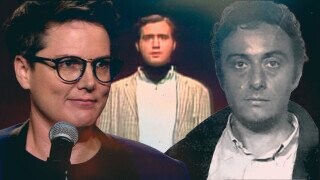A Timeline of People Trying to Reinvent Stand-Up

If you came to this article looking for celebrations of George Carlin, Richard Pryor, Joan Rivers or Chris Rock, look somewhere else. If we were carving a Mount Rushmore of stand-up, sure, those names would be on the short list for possible mountain desecration. But those comics represent the pinnacle of stand-up, not necessarily the reinventors of the form itself. Instead, let's look at six other comedians who fundamentally changed the game…
Click right here to get the best of Cracked sent to your inbox.
1953: Mort Sahl
Don't Miss
In an era when nightclub comics dazzled in sequined tuxedo jackets, Mort Sahl reimagined the art form in a V-neck sweater. “He took the stage in 1953, carrying a newspaper under his arm and talked about the news,” says Robert Weide, director of The Great Standups. “An early target was Joseph McCarthy and the Communist witch hunts conducted by the House Un-American Activities Committee. ‘HUAC’s enacting a new policy,’ Mort would say. 'For now on, every time the Russians throw an American in jail, we throw an American in jail.’”
“Sahl presented stand-up in a new way: conversational, literate and satirical,” says Wayne Federman in The History of Stand-Up: From Mark Twain to Dave Chappelle. San Francisco newspaper columnists raved, building a following for Sahl nearly overnight. “It seemed that more than just West Coast ‘intellectuals’ or ‘bohemians’ were thirsty for this new kind of comedy.”
“Simply put,” Weide says, “Mort Sahl reinvented stand-up comedy.”
1959: Lenny Bruce
The comedian released The Sick Humor of Lenny Bruce, his first comedy record, in 1959, embracing the “sick” label thrust upon him by Time Magazine and others.
Why were critics accusing Bruce of being “sick”? More than any of his contemporaries, he leaned into topics that were considered absolutely off-limits by the cultural (and actual) police: drugs, interracial sex, religion, masturbation, rape, homosexuality, racism, the Holocaust… you get the idea. Bruce’s multiple arrests for salty language and objectionable subject matter cost him a career but ultimately changed the game for Pryor, Carlin and the rest of his foul-mouthed, button-pushing comedy descendants.
1972: Andy Kaufman
Kaufman wasn’t a comedian, argues Bob Zmuda, Kaufman’s confidante and sometimes Tony Clifton alter-ego. “Andy was a behavioral scientist,” Zmuda says in Andy Kaufman: The Truth, Finally. “He was constantly measuring people’s reaction to stimuli. Andy instinctively knew back in ’72 what neuroscientists have recently discovered: that laughter is one way the brain deals with the discomfort of an embarrassing situation (Foreign Man), inappropriate jokes (Tony Clifton) or the surprise of an unexpected punch line (‘Take my wife… please take her’).”
But however you defined him, there was Kaufman taking the stage and making people laugh, expanding the entire definition of what stand-up comedy could look like.
1977: Robin Williams
Williams showed up to audition for the Comedy Store after only a year's stand-up experience in San Francisco. He tried out in bare feet, delivering what appeared to be a stream-of-consciousness spew of odd characters, literary allusions and pop-culture mash-ups. It was the improvisational nature of it all, delivered at breakneck speed, that felt so new.
To up-and-comer David Letterman, it was like Williams was performing an entirely different art. “We were just guys who stood behind the microphone and told jokes,” Letterman says in Dave Itzkoff’s biography Robin. “Robin comes in, and my memory of him is that he actually flew in — the energy gave one the impression that he was levitating. He seemed to be hovering above the stage and the tables and the bar. George and I would discuss Robin Williams endlessly, like, ‘What did we just see? How did he do it?’ Because he didn’t seem to have an act. And George and I would think, well, now, does that mean things have changed and we should leave the business?”
1991: Janeane Garofalo
We’re giving a nod to alt-comedy movement leader Garofalo, an honor she likely wouldn’t acknowledge (and could as easily be bestowed on Dana Gould, Beth Lapides and others). According to Federman’s History of Stand-Up, Garofalo had no interest in the polished set-up/punchline gags performed on The Tonight Show. So she and her comedy pals set up shows in L.A.’s Big & Tall Books, featuring performances that were confessional, off-kilter and experimental. Bring along a legal pad full of ideas and set it next to the mic? No problem.
The movement that ensued brought comics like Patton Oswalt, Margaret Cho and Maria Bamford into the fold, a template that defined the next decade or two of stand-up comedy.
2016: Hannah Gadsby
Most of the comics on this list didn’t set out to reinvent stand-up comedy. One could argue that with Nanette, Gadsby did.
“I was trying to work out ultimately whether some of my stories could be told onstage and made funny. I concluded early in the writing process that they could not be made funny, if told properly,” Gadsby told Vulture. “So I decided to then tell them properly and see what that does to a comedy show. I think we found out: It breaks comedy.”
One way comedy was broken: Gadsby’s refusal to throw in punchlines simply to ease an audience’s tension. “That is my instinct — to just do throwaway punch lines,” Gadsby says. “And it actually feels really counterintuitive up there when I’m just holding people in silence.”
Critic Matt Zoller Seitz saw the future: “Gadsby poses a question which, if answered affirmatively, would validate her stated wish to quit doing stand-up: What if ‘funny’ is the enemy of ‘honest,’ or at least at cross-purposes with it? “
“She wanted to change her comedy,” says Jesse David Fox in his Comedy Book. “Instead, she changed comedy.”